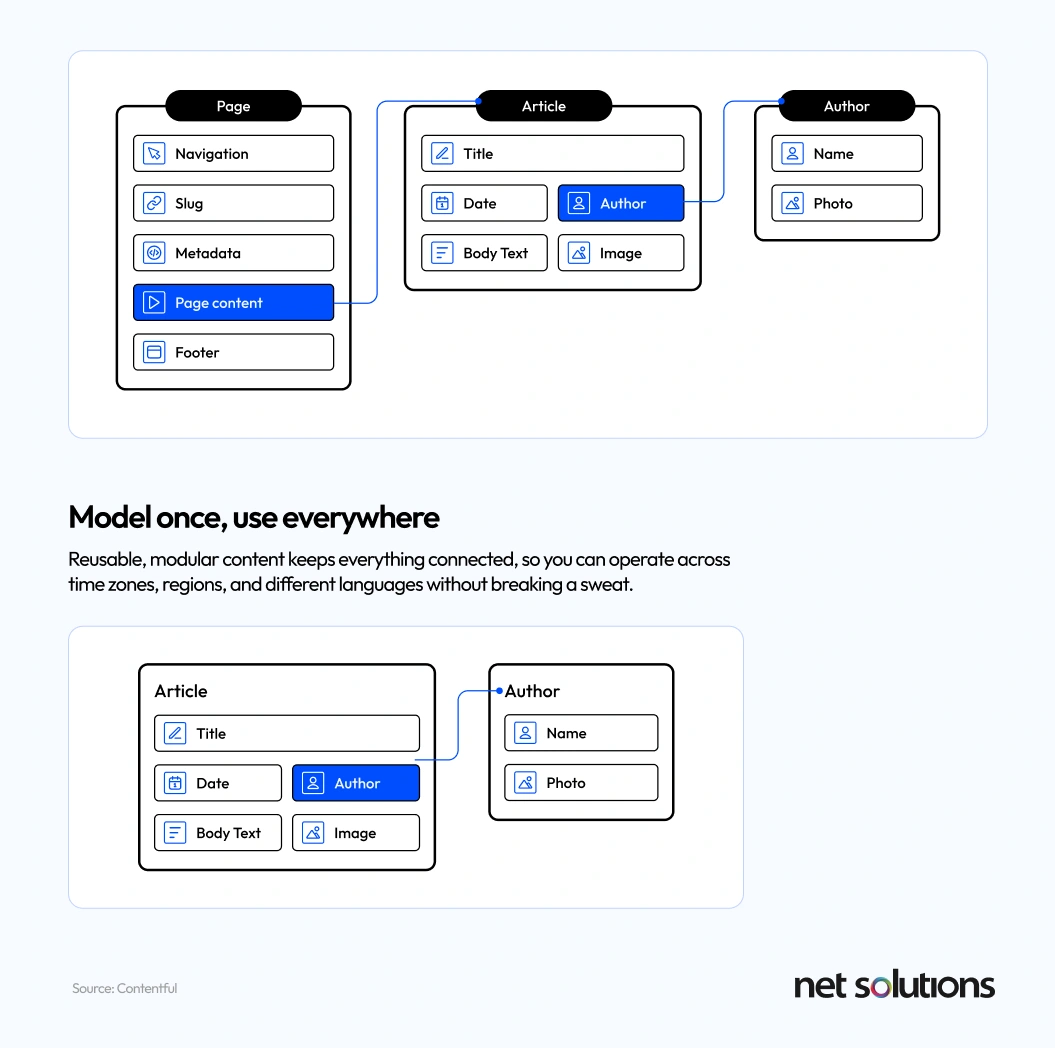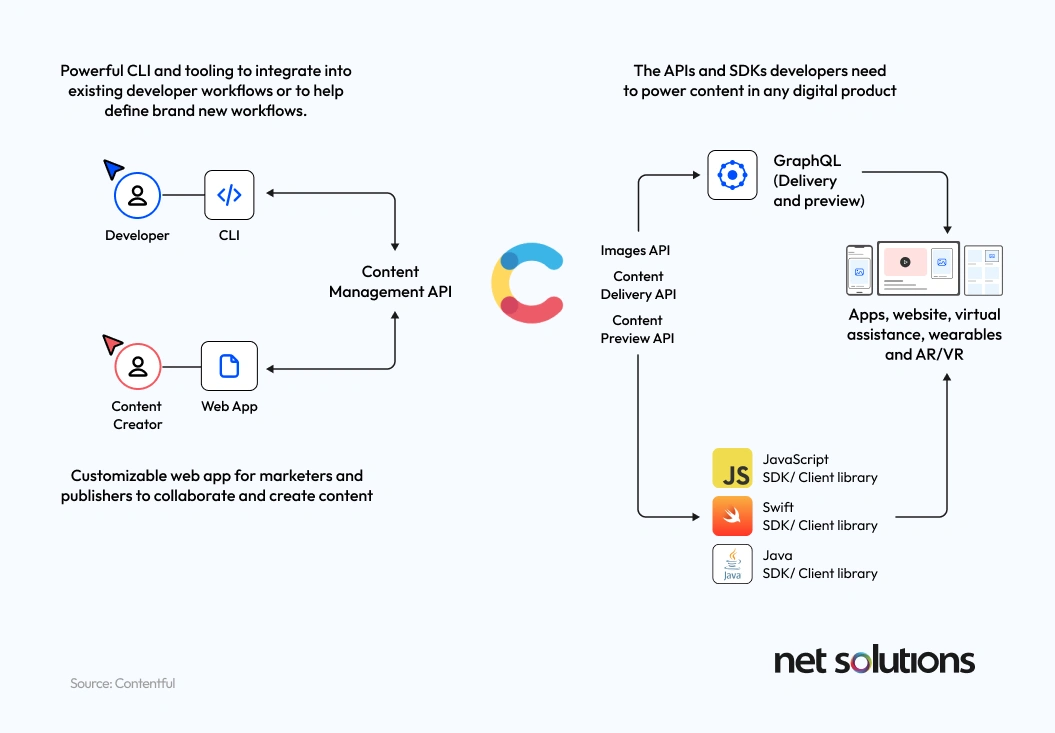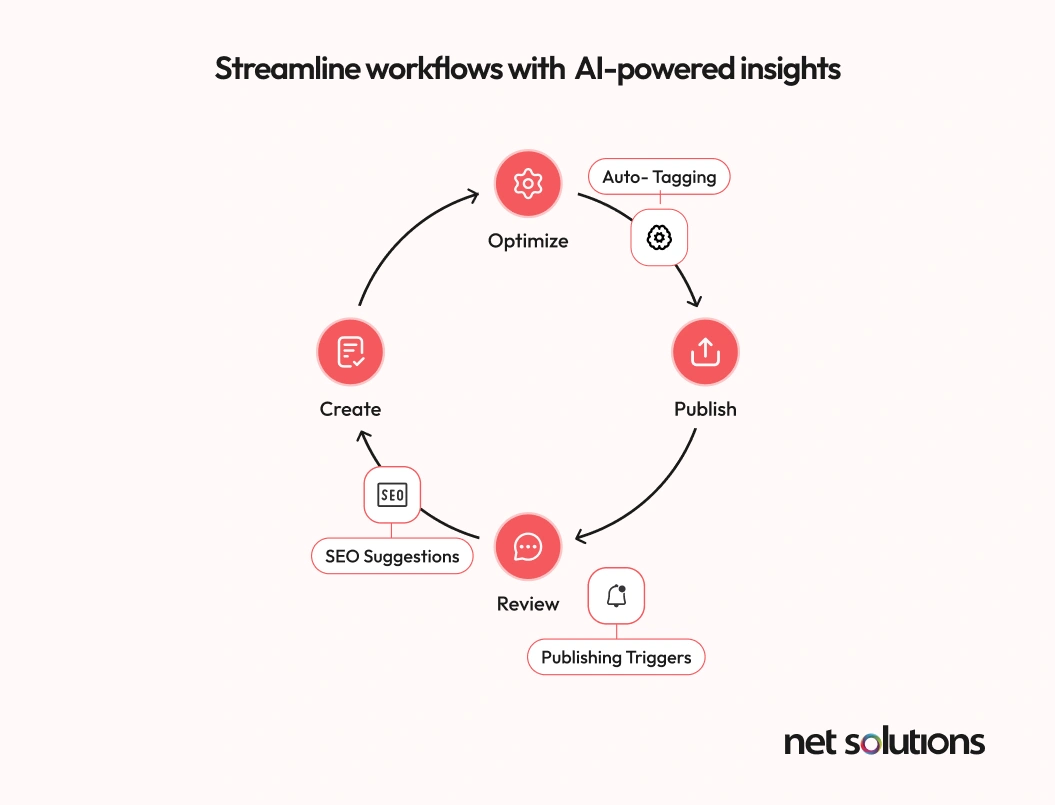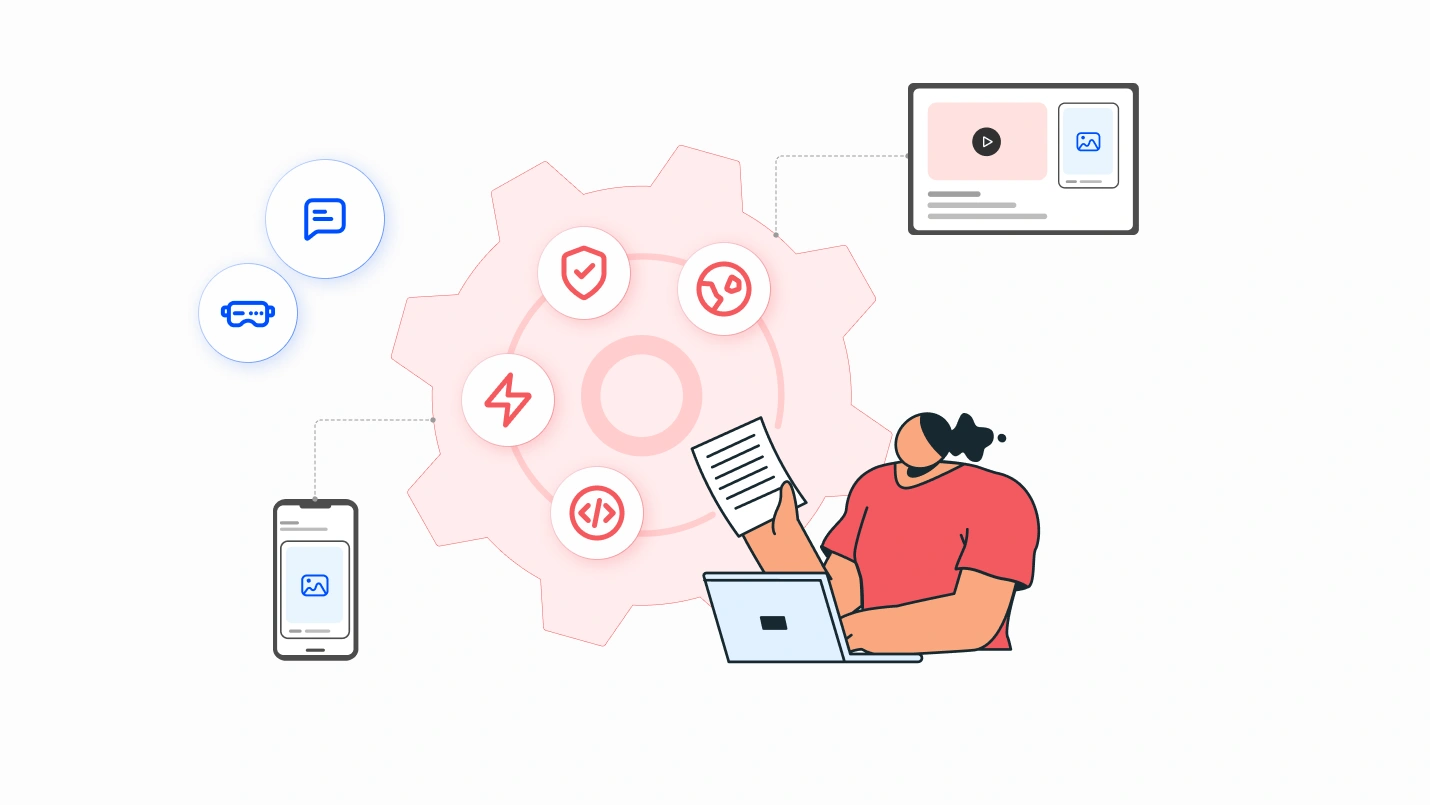Content now is a core business commodity. Still, most mid‑sized companies are using legacy content management systems, which hinder their progress. In an omnichannel world, audiences expect consistent experiences across websites, mobile apps, and emerging channels such as IoT devices. Your ability to create, manage, and deliver content effectively across channels can drive growth, so why not take advantage of it?
Unlike traditional CMS platforms, Contentful decouples the front‑end presentation layer from the back‑end content repository. This “headless” architecture means your developers are free to use any front‑end framework, while content teams manage structured content in a single hub. This separation allows developers and content teams to work independently, accelerating time‑to‑market and reducing friction. Thanks to its capabilities, Contentful enables digital teams to collaborate more effectively. Throughout this article, we’ll explore why Contentful’s features make it a smart choice for businesses seeking scalability, flexibility, and faster innovation.
Top Contentful Features That Make It Enterprise-Ready
Compared to monolithic, headless CMSs are more scalable, secure, compatible with newer technologies, and more developer-friendly. Here is the proof that headless is the promising future of content management systems:
The headless CMS market was valued at around USD 605 million in 2022 and is projected to reach USD 3.8 billion by 2032, growing at a compound annual growth rate (CAGR) of around 22%.
Enterprises increasingly view headless CMSs as foundational to omnichannel experiences, enabling faster content deployment and personalized engagement across devices.
Now, let’s consider the leading capabilities that make Contentful enterprise-capable.
1. Structured Content Types
A Contentful CMS organizes content into reusable units called content types (product information, calls to action, or headlines) and posts that can be published to any platform. Unlike traditional content systems that tie content to specific pages, Contentful’s modular architecture separates content from layout. This ensures fast updates, consistent messaging across channels, and easy reuse across web, mobile, email, and other platforms.
Benefits:
- Faster publishing
- Lower content duplication
- Easier omnichannel delivery
Here’s a glimpse of how Contentful helps model your structured content – breaking down smaller pieces so that they can be easily assembled into different experiences across channels and devices.

2. Headless, API-First Architecture
Contentful uses powerful, flexible RESTful and GraphQL application programming interfaces that help put content anywhere – sites, mobile apps, wearables, and more. The headless architecture that separates content and business logic from the design and interface with APIs enables developers to create customized experiences on platforms and third-party tools. Contentful supports making API calls across all languages, platforms, and frameworks, so developers using Contentful can choose any technology that they like.
Why it matters:
You’re not locked into a single delivery method. You gain the freedom to craft tailored digital experiences across platforms using your preferred tools. For instance, a retailer can build a React‑based e‑commerce storefront and a native iOS app from the same content repository, ensuring a unified brand experience across devices.

3. Unified Brand Experience
Centralized content, distributed across platforms via APIs, ensures a cohesive brand voice. Whether customers visit your app or website, they get a consistent, high-quality experience. This consistency helps build trust and reinforces brand recognition, which are critical for customer loyalty.
Especially for eCommerce brands, speed, personalization, and omnichannel consistency are crucial. Contentful helps streamline all three. By decoupling content from the presentation layer, retailers can rapidly update product listings, promotions, and checkout flows without redeploying their entire website. You can explore our deep dive on how to drive eCommerce sales with Contentful to learn how content‑driven experiences can impact conversion rates and retention.
4. Editor-Friendly Interface
Contentful offers a simple, easy-to-use interface that makes it easy for your non-technical teams to manage content independently. Tools like the entry editor and media library give marketers more control without the need for developer help. Plus, with customizable UI extensions, teams can tailor the interface to their workflow, making everyday content tasks faster and more efficient. As a result, marketing teams can publish campaigns in hours instead of days, reducing dependencies on IT teams.
5. Secure Collaboration via Permissions
With Role-Based Access Control (RBAC), Contentful enables granular access control by defining explicit user roles such as authors, editors, and reviewers. It provides a safe method of managing sensitive workflows like legal reviews while maintaining content security and integrity.
In sum, it ensures:
- Secure handling of sensitive content
- Streamlined approval workflows
- Enhanced compliance and governance
For organizations in regulated industries like healthcare or finance, granular permissions provide an audit trail and minimize risks of unauthorized changes.
6. Built-In Localization
This CMS supports multi‑language content through its localization feature. This means you can keep translations in a single structure and avoid duplicating content across regions. Localization isn’t just about translation, it’s about tailoring content to different cultural contexts and legal requirements. Contentful’s tools allow regional teams to manage variations without recreating the entire content structure.
7. Content History and Audit Trails
Contentful automatically tracks every change made to content entries. So, your team can roll back changes, track edits, and maintain complete visibility-a requirement for industries with strict compliance and documentation needs. Versioning also allows teams to experiment with different content variations and easily revert if the new version doesn’t perform as expected.
Advanced Features for Marketing and Product Innovation
Profound capabilities of Contentful help teams deliver compelling, consistent experiences more easily.
1. Contentful Studio
Using prebuilt components of the Contentful content model, marketers can visually create and update layouts. And they don’t require any dev resources for coding. Contentful’s drag-and-drop interface reduces time-to-launch and allows your teams to work independently. Marketers can A/B test layouts, adjust hero banners, and swap CTAs in real time—all without writing a single line of code.
2. Artificial Intelligence and Workflow Automation
You can speed up the creation and optimization of content with AI-powered capabilities. They include content suggestions, SEO optimization, and more. Also, with workflow automations, the content lifecycle runs smoothly.

According to PwC’s 2025 Digital Trends in Operations Survey, AI (59%) is one of the top technologies used by companies, along with cloud (56%), for increasing productivity. Nearly all respondents believe these technologies create value in terms of revenue growth, productivity gains, or cost control. Contentful’s built‑in AI features align with these trends by providing automated tagging, personalization suggestions, and SEO recommendations, helping teams work smarter.
3. Personalization at Scale
From browsing history to geographic data, the Contentful personalization feature simplifies the process of delivering experiences that resonate with specific behavior and preferences. By integrating with your CRM and analytics tools, Contentful can segment audiences and serve relevant content—such as location‑based promotions or recommended articles—without manual intervention.
4. App Framework & Ecosystem
Contentful offers a robust app framework and growing marketplace of pre-integrated applications from analytics to translation, commerce, and more. You can also build your own custom integrations to exactly fit your tech stack. This ecosystem means you’re not starting from scratch when connecting Contentful to tools like Shopify, Algolia, or Salesforce.
The Tools for Developers to Build Faster and Smarter
Developers can use APIs, flexible SDKs, and up-to-date integrations of Contentful. With these tools, it is easier to create fast, scalable, and customized digital experiences.
1. Software Development Kits
Contentful supports a range of essential software development kits (JavaScript, Python, Swift, Ruby) to accelerate implementation on any platform. So, developers can get started quickly and tailor content delivery to fit any use case. For example, a React developer can use the Contentful JavaScript SDK to pull dynamic content into a single‑page application, while a Swift developer can use the iOS SDK to render the same content in a native app.
2. Webhooks for Real-Time Integration
With Contentful benefits, your content updates are always in sync. You can notify third-party systems when content changes, such as when you rebuild a static site, or alert your team in Slack when needed. This real‑time capability ensures that changes made in Contentful propagate instantly across your digital properties, improving agility and reducing errors.
CLI & Migration Utilities
Contentful’s Command-Line Interface (CLI) streamlines schema migrations, seed data management, and automating workflows. When migrating from a legacy CMS, the CLI helps you map old content structures to Contentful’s content types, reducing downtime and errors.
Why Contentful Matters for Your Business
Below, you can see how the Contentful headless CMS creates a difference for core teams:
- For Business Leaders: Contentful enables faster campaign launches, reduces IT overhead, and builds a future‑proof digital foundation. Instead of waiting months for a site redesign, executives can test new business models and pivot quickly in response to market changes.
- For Marketing Teams: This CMS ensures consistent messaging across channels, enables real‑time updates, and helps teams to collaborate without tech bottlenecks. Marketers gain autonomy to manage landing pages, promotional banners, and localizations, freeing developers to focus on innovation.
- For Developers: They don’t need to manage large or complex content setups. Developers can use API flexibility, modular content, and seamless integration with next‑generation tools. Modern tooling, including robust SDKs, GraphQL support, and CI/CD integrations, means developers can focus on building engaging experiences rather than wrangling data structures.
Common Pitfalls and How to Fix Them
No tool is perfect. Contentful has its learning curve.
For example:
- Complex content modeling can be overwhelming.
- Integration issues can occur without proper planning.
- Non‑technical teams may need onboarding support.
To mitigate these challenges:
- Invest in content modeling workshops to align your content structure with business goals.
- Start small with a pilot integration to validate your API workflows before rolling out across all systems.
- Provide training for non‑technical users, focusing on how to create, edit, and publish content safely.
We’ve broken down 7 common Contentful challenges along with actionable fixes to help you avoid common implementation mistakes.
Conclusion
Contentful is more than a CMS; it’s a flexible content platform designed to grow with your business. From structured content types to personalization, APIs, and developer tools, the platform offers everything needed to power modern digital experiences. As the headless CMS market continues its rapid expansion, adopting a solution like Contentful positions your organization for future success.
If you’re ready to take the next step, Net Solutions is here to help. As a certified Contentful partner, we offer implementation, migration, and customization services tailored to your business needs. Contact our team to get started with Contentful today.
Frequently Asked Questions
1. What is Contentful used for?
Contentful is a great tool to organize, manage, and serve content on websites, apps, and digital platforms from a single backend—to provide fast, flexible, and consistent content experiences.
2. What does Contentful do?
Contentful disassembles content into reusable modules and delivers it via APIs, so that teams can produce, manage, and deliver content on any channel without relying on a traditional page-based CMS.




